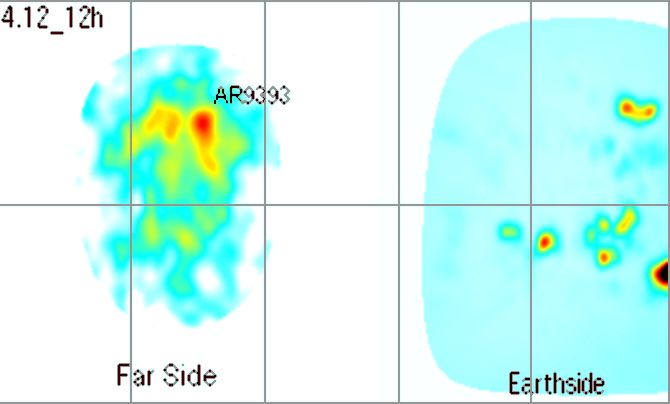Explanation: You may think it's impossible to see through the Sun, but maps of the Sun's far side are now made routinely by instruments on board the sun-staring SOHO spacecraft. This is one such map from April 12. At right, is a map projection of calculated magnetic field strengths on the Earth-facing solar hemisphere with yellow and red indicating high magnetic fields characteristic of solar active regions. At left is a similar map of the solar hemisphere opposite planet Earth, which shows the large active region AR9393 as the 27-day solar rotation carried it across the far side. The largest sunspot group in a decade, AR9393 was easily seen as it tracked across the Sun's Earth-facing hemisphere in late March. When AR9393 swung around to the Sun's far side, SOHO's Michelson Doppler Interferometer (MDI) instrument continued to map its position by measuring changes in motions caused by solar sound waves - transmitted through the Sun and influenced by the active region's strong magnetic fields. Known as helioseismology, analyzing solar sound waves is like using seismological records of earthquakes to probe the interior of the Earth. On the Sun, sound waves are produced by turbulent convection cells seen on the surface as dynamic solar granules.
1998 1999 2000 2001 2002 2003 2004 2005 2006 2007 2008 2009 2010 2011 2012 2013 2014 2015 2016 2017 2018 2019 2020 2021 2022 2023 2024 |
Январь Февраль Март Апрель Май Июнь Июль Август Сентябрь Октябрь Ноябрь Декабрь |
NASA Web Site Statements, Warnings, and Disclaimers
NASA Official: Jay Norris. Specific rights apply.
A service of: LHEA at NASA / GSFC
& Michigan Tech. U.
|
Публикации с ключевыми словами:
ar9393 - active region - helioseismology - far side - Sun - Солнце - обратная сторона - гелиосейсмология - активные области
Публикации со словами: ar9393 - active region - helioseismology - far side - Sun - Солнце - обратная сторона - гелиосейсмология - активные области | |
См. также:
Все публикации на ту же тему >> | |
